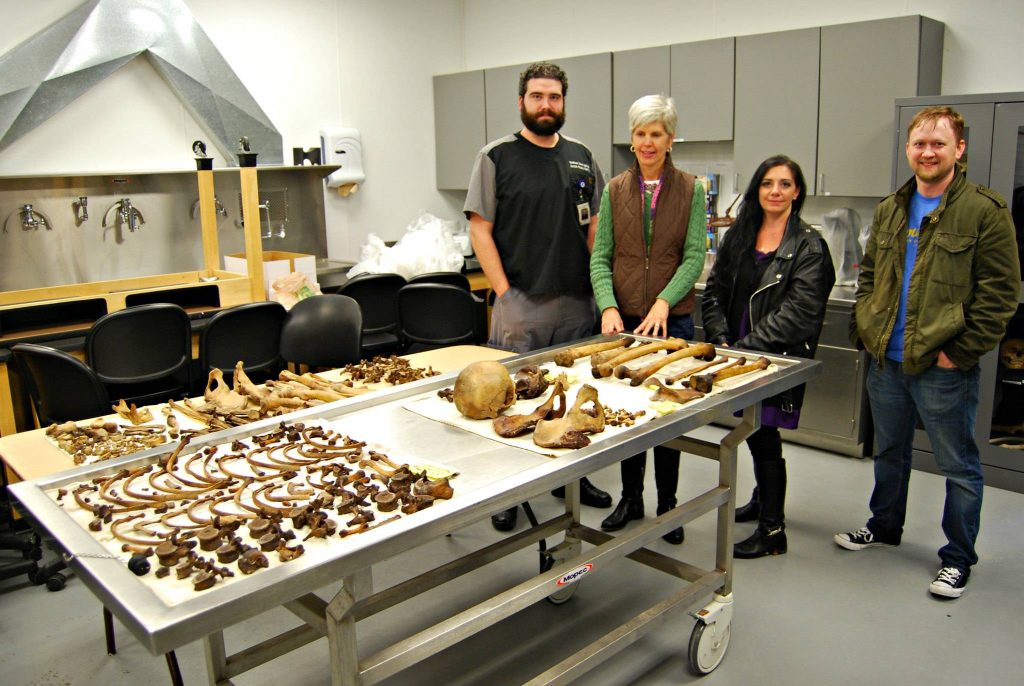It bugs the hell out of me why this has not been solved.
Murder in Room 1046 & the Mystery of Artemus Ogletree

In the New Year of 1935, a man checked into a hotel in Missouri, only to have his stay marred by unusual behaviour, bizarre communication, and ultimately, his mysterious death.

This and NINETEEN other true crime stories and mysteries can be found in Bizarre True Crime Volume 6, available from Amazon.
A curious guest
When bellboy Randolph Propst left home for his shift at the Hotel President in Kansas City, Missouri, he wasn’t expecting anything less than a normal day at work. Carrying luggage, welcoming guests, and taking bags to guests’ rooms was all part of the job.
On 2nd January 1935, a single man checked himself into the hotel under the name of Roland T. Owen. Randolph showed Roland to room 1046 on the tenth floor, but didn’t carry any bags, as Roland didn’t have any.
All he had was a comb, a brush, and toothpaste. He also had a strange bald patch on the side of his head.
In conversation, 19-year-old Roland said he had spent the night at the nearby Muehlebach Hotel, now the Kansas City Marriott, but claimed the rate was a little too high for his liking and preferred the inner rooms of the Hotel President.
After placing his comb, brush, and toothpaste on the side, Roland followed Randolph back out the room. Randolph locked the door for him and gave him the key, then watched with curiosity as Roland walked out the hotel and into the city.
Do not disturb
Two days later, on 4th January, switchboard operator Della Ferguson arrived for her shift to find the indicator light was on for room 1046. As the room’s phone was off the hook, she called through to the main desk who sent Randolph to check what was needed.
When he arrived at the room, the ‘do not disturb’ sign was hanging on the door’s handle. He knocked numerous times and a voice from inside told him to enter and then to come in. But the door was locked from the inside, so Randolph went back down to the main desk.
He told Della that the man was probably drunk and to wait another hour before sending him back up. An hour later, another bellboy, Harold Pike, went to the room with a key, and let himself in.
The curtains were closed and the room was dark but he could see that Roland was naked on the bed. He put the phone back on the hook and apologised for the disturbance.
Another hour passed, and the operator saw the phone was off the hook again. This time, Randolph went back upstairs to the room and knocked before letting himself in with a key. Inside, Roland was on his hands and knees crawling towards the door. Randolph turned the light on and recoiled in shock.
Roland was covered in blood, as were the walls and ceiling of the main room and the bathroom. Randolph ran back downstairs to raise the alarm.
The assistant manager and another hotel worker managed to sit Roland on the side of the bathtub, where they saw his injuries and immediately called the police.
Final words
He had been stabbed multiple times in the chest, with two wounds having punctured his lung, and one barely missing his heart. His wrists and ankles had been tied with electrical cord, with another stretch of cord around his neck.
The bruising around his neck suggested someone had tried to strangle him. He had also been hit over the head multiple times that had resulted in a skull fracture. When police arrived with a doctor, they cut him free from the cords and rested him on the bed.
When asked by the doctor who had done this to him, he answered with a confident ‘nobody’. As he began to pass out from his wounds, he said he had fallen and hit his head on the bathtub. The doctor asked him if he had been trying to kill himself, and Roland responded with ‘no’.
Moments later, he lost consciousness, just as the paramedics arrived. He was taken to a nearby hospital but arrived in a comatose state. Shortly before midnight on 5th January, Roland died of his injuries. And so began a mystery that has perpetuated for close to a century.

Voices
When police investigated the incident, many employees of the hotel came forward to talk about the strange experiences they’d had with Roland and the room itself.
The day Roland checked in, one of the hotel maids, Mary Soptic, was doing her rounds on the tenth floor, when she entered room 1046.
Even though she had knocked, Roland was inside the room and the curtains were drawn. She apologised but noted he had an appearance of someone who was scared for his life. He told her to keep the door unlocked as he was expecting someone.
The following morning, on the 3rd, Mary entered the room again to clean it, and Roland was inside the room talking to someone on the phone. She later recalled that she overheard him saying; ‘no, Don, I don’t want to eat, I’m not hungry. I’ve just had breakfast. No, I am not hungry.’
That same afternoon, Mary was giving the rooms fresh towels to replace those taken in the morning clean-up. As she approached room 1046, she heard two male voices. When she knocked saying she had fresh towels, an unidentified man said, ‘we don’t need any’.
That same afternoon, Jean Owen checked into the hotel and was given room 1048, next door to Roland’s room. It would become a source of much confusion down the line, as Jean had the same surname as the one Roland had given.
That evening, her boyfriend visited her and stayed for two hours, before leaving at around 11pm. She later claimed she heard male and female voices shouting and cursing at each other but couldn’t pinpoint exactly what room they were coming from.
Due to her having the same surname and the room next door to Roland, police arrested her for those reasons only. It wasn’t until her boyfriend arrived at the police station to back up her story, that Jean was released.
The sex worker
The same night that Jean heard the voices, elevator operator Charles Blocher started his shift. He usually worked the midnight to 8am shift and was used to drunk people coming back from a night out or attending a room party.
He recalled to police that a loud party was taking place in room 1055 but it was not within his job description to quiet them down. He felt guilty taking people to the tenth floor where it had become unusually loud.
At around 1am, a familiar woman entered the lift and asked for room 1026. Charles recognised her as she would often come to the hotel to visit men in their rooms at all hours of the night. He agreed with other staff members that she was a sex worker on out-calls.
Five minutes later, she walked past the lift, which was waiting on the tenth floor, and claimed that her client was not in room 1046, despite having said 1026. She said she was familiar with her client and he was always ready with the light on, before walking off to find the right room.
Half hour later, she took the elevator back down to the lobby. At 4am, the same woman got into the elevator with a new man, and Charles took them to the ninth floor.
15 minutes later, the man went back down to go for an early morning walk. According to Charles, they were the only two people that seemed suspicious at any point during the night.

An alias
An autopsy determined Roland had died of the wounds that had been inflicted, and that they were more than likely caused by another person, rather than self-inflicted. The medical examiner concluded the wounds had been caused between 4am and 5am on the 5th.
The investigation didn’t find much evidence in the room besides the voluminous amount of blood splatter on the walls, floor and ceiling. There were no belongings and no extra clothes, with the only items being the comb, brush, and toothpaste that Randolph had seen.
Suicide was touted as a cause of death despite the coroner saying otherwise, but there were no knives in the room. The only other items they found were the two room glasses, one had been chipped and left in the sink, a hairpin, one unsmoked cigarette and a full bottle of diluted sulfuric acid.
Detectives lifted fingerprints, small enough to belong a female, from the room’s telephone. All the staff members in the hotel provided fingerprints and personal information but none of them matched the prints on the phone.
When they ran Roland’s records, the mystery deepened, as Roland T. Owen was an alias but they couldn’t discover who he really was. As the story hit the press, sightings started to come in from all over the city but still, no-one knew his real name.
Sightings
On the night of the 4th, a city worker named Robert Lane, claimed a man had jumped into his vehicle believing him to be a taxi driver, which he wasn’t. The man was wearing an undershirt, trousers and shoes, and had a large cut on his arm, that he was holding to stop the blood coming out.
Lane dropped him off at a taxi rank but it wasn’t until he read the press stories that his curiosity was roused. Three months later when the funeral was finally held, Lane went to view the body and saw a cut on the dead man’s arms that looked remarkably similar to the man who climbed into his vehicle.
He told police he believed the man he picked up was the man who was later killed that night. The problem was that none of the workers in the hotel saw Roland leave his room at any time on the 4th.
Another sighting was by a bar worker in the city, who had seen the dead man drinking with two women on the 3rd and according to what he overheard, they were moving from bar to bar. Other bars in the city seemed to back up the sightings.
As the story went nationwide, a huge number of tips came into the offices of the Kansas City Police Department, and for a while they were inundated with leads that went nowhere.
Just a few days after the mystery man died, two more homicides occurred across the city, and the investigation into Roland began to die down.
Ogletree
On 3rd March of the same year, the mystery Roland was due to be buried and a funeral held. Once the funeral home released the schedule, they too were inundated with phone calls and tips. One person said the man would finally be buried next to his sister.
Another claimed the man had been married at the time he had an affair, hence the reason he was killed. The caller had arranged two women and himself to visit him at the hotel to dish out the ‘justice that cheaters deserve.’
The funeral was postponed for three weeks to allow police to once again comb through all of the leads, including flowers that had been sent with different names on. Detectives also posed as gravediggers in the days that followed, in case of unexpected visitors to the burial site.
18 months later, in Alabama, a friend of Ruby Ogletree gave her the latest issue of The American Weekly which contained a rerun of the mysterious murder story. Ruby’s friend had noticed something about Roland that may have interested Ruby.
Ruby saw straight away that the unidentified Roland was in fact her son, Artemus Ogletree. She got in touch with the Kansas City PD and they managed to confirm that the unidentified man was in fact her son.
He had left Alabama for California in 1934, hitchhiking his way there. It was the last time she had ever seen him alive. An official identification was quickly given out to the press, but shortly after, the plot, yet again, thickened.

Mystery letters and phone call
Artemus was born in Florida in 1915 and had two siblings. The mysterious bald patch on the side of his head was the result of a childhood accident when hot oil left a large scar. The bald patch was the result of not being able to grow hair after the accident.
Ruby was unaware her son was dead because bizarrely she had been receiving letters from him after he had died. Before his death, Artemus had been writing letters home to let his family know where he was, but in early 1935, Ruby began receiving typed letters from locations across the United States.
She had a feeling something may have been wrong as Artemus didn’t know how to type, and the words didn’t match his voice or style of writing. In May 1935, she received a letter from New York that said he was going to Europe, and a second one claiming he was on the next ship out.
Then in August 1935, she had received a phone call from a man in Tennessee who claimed that Artemus had saved his life in a fight and that he was now in Cairo living with a woman of great wealth. The man gave his name but it has never been publicly released and there was no evidence that Artemus – or Roland – had left the United States.
In 1937, police discovered Artemus had stayed in a third hotel, the St. Regis in Kansas City. According to hotel records he had stayed in the room with another unidentified man.
It led the investigation to believe the man he had stayed with was the man he was overheard calling Don. Since 1937, the investigation went cold but was reopened every now and again as new leads came in.
Theories with little evidence
Due to the lack of solid evidence or suspects, many theories have since arisen. Many suspect he was involved in organised crime, while others suggest he was killed by a jilted lover. Over the years, various letters and phone calls have been received by the Kansas City PD but rather than helping solve the murder, they simply added to the pile of leads that went nowhere.
During his stay in Kansas, Artemus used three different names to check into three hotels, none of which have any bearing on the case. At the first hotel, he stayed there with another man. It’s not much of a stretch to assume they were having a sexual relationship.
Artemus may have moved hotels to get away from the man, who followed him to the Hotel President, and was the man heard on the other side of the door, and the one referred to as Don.
It’s also possible that Artemus may have been having an affair with a married woman and that the other man in the room was her partner, seeking to solve the problem.
An unidentified woman’s fingerprints were found on the telephone in his room. There were two possibilities, one that it was the person he could have been having an affair with, the other was the sex worker who had visited the hotel that night.
The theory goes, that after their encounter, Roland had no money to pay her, and she went to get her pimp, who was the man she was seen in the elevator with an hour later. The same man who left the hotel 15 minutes after to get some fresh air and never returned.
Murder mystery
The phone call to Ruby Ogletree was too detailed to have been completely untrue. The man claimed Artemus had protected him during a fight, which verified the city worker’s account of an injured man looking like Artemus getting into his vehicle thinking it was a taxi.
It might have been possible that Artemus received his injures during the fight but that wouldn’t explain the blood splatted all across the hotel room, which was evidence enough that he had been attacked in the hotel room itself.
Other theories suggest one of the two bellboys or even the maid had killed him and possibly colluded to make it look like someone else. Yet, there was no obvious motive, and in fact motive was something sorely missing from the investigation, for without it, cases are always harder to solve.
Some later theories suggested that Artemus attacked himself, which makes little sense, as he was tied up at both the wrists and ankles. He would not have been able to stab himself, fracture his skull, then tie himself up in the way he was found.
The case of the murder in room 1046 is a mystery that has stood the test of time, simply because the deeper we go, the more confused and mysterious it gets. It’s one of those cases that never goes away, in the hope that one day, the truth will come out, and Artemus will finally be laid to rest.
This and NINETEEN other true crime stories and mysteries can be found in Bizarre True Crime Volume 6, available from Amazon.
- What Happens to Cold Cases? The Intricacies and Unsolved Mysteries Explained

- 13 Facts You Need to Know About Levi Bellfield: The Bus Stop Stalker

- How Has Pathology Evolved Over Time? (History of True Crime)

- Trio Convicted of June 2022 Westminster Murder of Adnan Saleh

- How Did Forensic Science Evolve Through History? (History of True Crime)

I feel like there should be more killers who use the internet especially in today's world.
Thanks for this. Anymore podcast lists coming anytime soon??
Not just females.
[…] Not So Heavenly Creatures: The case of two teenage girls who fell in love, created their own religion, entered…
There's a lot more the Italian authorities are not releasing over this case. Makes you wonder the extent of the…

 T
T
What Happens to Cold Cases? The Intricacies and Unsolved Mysteries Explained

 T
T
13 Facts You Need to Know About Levi Bellfield: The Bus Stop Stalker

 T
T
How Has Pathology Evolved Over Time? (History of True Crime)

 T
T


